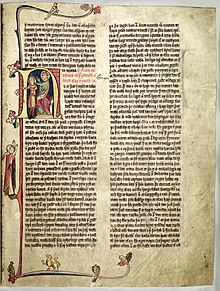AM 227 fol. is a fourteenth century Icelandic illuminated manuscript.[2] It contains a version of Stjórn, an Old Norse biblical compilation, and is one of three independent witnesses to this work.[3] It is lavishly illustrated and is one of the most impressive manuscripts collected by Árni Magnússon.[4]

Description and history
editThe codex now measures 35 cm × 27 cm (14 in × 11 in) but was originally larger, having been trimmed, probably during the late seventeenth century when it was bound.[5] In its current form, the manuscript has 128 leaves, but may originally have comprised 150.[4] Five leaves of the manuscript were obtained by Árni Magnússon after he collected the codex itself.[5] Árni Magnússon received the codex from Bishop Jón Víldalín in 1699; it had previously belonged to Skálholt Cathedral.[6] AM 227 fol. was at Skálholt in 1588 and is likely to be the 'Bible in Icelandic' mentioned in an inventory of 1548.[7]
The Stjórn exists in three parts. Only AM 226 fol. contains all three; it originally contained just parts I and III, but part II was added in the fifteenth century. AM 227 fol. contains Stjórn I and III. However, the last leaf of gathering 10 and the first of gathering 11 were left blank. This gap may have been left for Stjórn II.[8]
Scribes and illuminator
editThe manuscript was written by two scribes, known as A and B. These scribes also produced another Stjórn text, AM 229 fol.[4] They also appear together in AM 657 a-b (which includes Klári saga).[4] Hand B is also represented in the Stjórn fragment NRA 60A and copied part of Rómverja saga in AM 595 a-b 4to.[4][9] Hand A is best known from Codex Wormianus (AM 242 fol.) but also worked on AM 127 4to (Jónsbók), GKS 3269 a 4to (Jónsbók), AM 162 a fol β (Egils saga), AM 240 fol IV (Maríu saga), AM 667 4to IX (Jóns saga baptista), NRA 62 (Karlamagnús saga) and AM 554 40 fols. 20r-21r (Völuspá in Hauksbók).[10]
The manuscript was illuminated by the main illustrator from Þingeyrar, who was also responsible for the earliest part of Teiknibók.[11] The iconographic imagery of the Þingeyrar manuscripts Teiknibók, AM 227 fol. and AM 249 e fol. shows influence from fourteenth century East Anglian manuscript illustration.[12]
References
edit- ^ Benediktsson, Jakob (2004). "Some Observations on Stjórn and the Manuscript AM 227 fol". Gripla. 15: 14 – via Tímarit.is.
- ^ "Stjórn | AM 227 fol". Handrit.is. Archived from the original on 6 May 2015. Retrieved 2020-01-04.
- ^ Benediktsson (2004), p. 43.
- ^ a b c d e Bernharðsson, Haraldur (2015). "Stjórn, the Old Testament in Old Norse". In Driscoll, Matthew James; Óskarsdóttir, Svanhildur (eds.). 66 Manuscripts from the Arnamagnæan Collection. Copenhagen and Reykjavík: The Arnamagnaean Institute, Department of Nordic Research, University of Copenhagen; The Árni Magnússon Institute for Icelandic Studies; Museum Tusculanum Press, University of Copenhagen. p. 158. ISBN 978-87-635-4264-7.
- ^ a b Benediktsson (2004), p. 8.
- ^ Benediktsson (2004), p. 11.
- ^ Benediktsson (2004), p. 12.
- ^ Benediktsson (2004), p. 24.
- ^ Benediktsson (2004), p. 16.
- ^ Benediktsson (2004), p. 17.
- ^ Drechsler, Stefan Andreas (2017). Making Manuscripts at Helgafell in the Fourteenth Century (PhD). University of Aberdeen. p. 43.
- ^ Drechsler & (2017), p. 227.